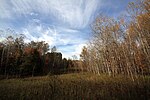Trisan Centre

The Trisan Centre is a community recreation centre in Schomberg, Ontario, Canada located at the intersection of Dillane Drive and York Regional Road 27. It has a fitness centre, and a 600-seat arena that is the home rink of the Schomberg Cougars, an ice hockey team of the Ontario Hockey Association, and the Schomberg Minor Hockey Association of the Simcoe Region Minor Hockey League. The King Curling Club also uses the arena. Local construction company Trisan Construction purchased the naming rights to the arena for 50 years. The building was inaugurated on June 27, 2011 by township mayor Steve Pellegrini, the township's six councillors (Bill Cober, Avia Eek, Peter Grandilli, Cleve Mortelliti, Linda Pabst, and Debbie Schaefer), York Regional Council chairman Bill Fisch, provincial representative Helena Jaczek, and federal representative Paul Calandra.
Excerpt from the Wikipedia article Trisan Centre (License: CC BY-SA 3.0, Authors, Images).Trisan Centre
Dillane Drive, King
Geographical coordinates (GPS) Address Nearby Places Show on map
Geographical coordinates (GPS)
| Latitude | Longitude |
|---|---|
| N 44.005555555556 ° | E -79.676111111111 ° |
Address
Dillane Drive
L0G 1T0 King
Ontario, Canada
Open on Google Maps





